Acquisitions: Wooden pipes from Portugese Africa
Auteur:
Don Duco
Original Title:
Aanwinsten: Houten pijpen uit Portugees Afrika
Année de publication:
2008
Éditeur:
Pijpenkabinet Foundation
Magazine:
Nieuwsbrief Pijpenkabinet
Description :
Discussion and illustration of three remarkable wooden pipes from Angola acquired by the Pijpenkabinet museum
A pipe shaped as a rifle
This relatively small wooden tobacco pipe (length 24 centimetres) shows an unexpected design representing a rifle. The subject of a pistol or rifle is quite popular among African tribes and is more often chosen as a starting point for the design of pipes. Reason of course is the admiration for guns in that continent. The pipe discussed here was recently acquired for the Pijpenkabinet collection and originates from Angola. It dates between 1900 and 1920.

The illustrated pipe is made in the usual techniques that were applied to ordinary pipes from this region as well. The pipe bowl is made out of soft wood, carved in the basis shape. This type of wood burns quickly, so the inside of the bowl has to be protected against the fire by lining it with metal. However technically suitable, it won’t make a tasteful pipe. Only after several times of smoking the carbon layer will reduce the nasty metal taste.
The pipe stem is formed by a simple iron tube, that fits well in the design because of it resembles a rifle barrel. On the top of the stem even the trigger is indicated. The connection between the two materials is made by several metal bands of thin plate metal, both for reinforcement and decoration. Apart from the alteration of metal and wood, the decoration continues at the sides of the pipe bowl and the rifle butt with a pattern of drillings.
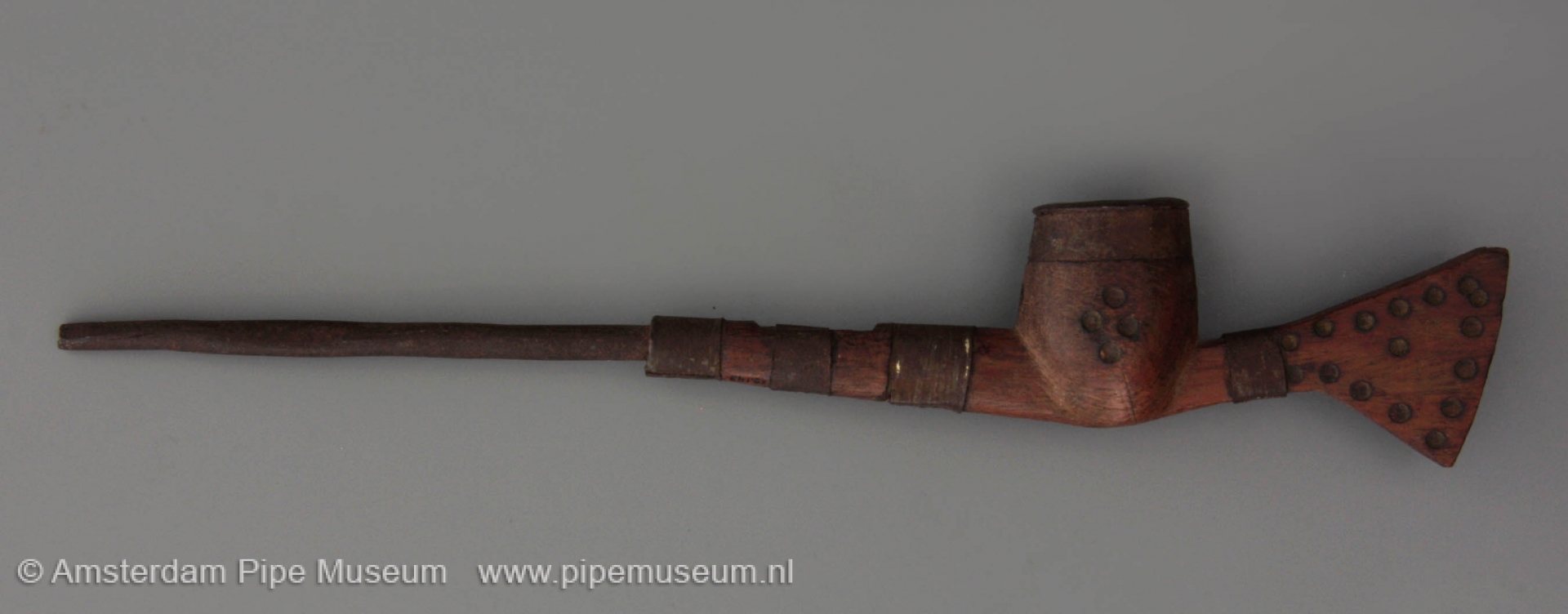

It is not easy to attribute this kind of pipe to a specific tribe. The decorative patterns, the techniques and materials are not exclusively used by one tribe, but are known in a larger area. There is, however, a resemblance with ordinary smoking pipes from South-Angola, that suggest this provenance. As we said before, the rifle theme is known form other countries such as Congo and Uganda. Even in China there is a reference made to fire arms, as the opium pipe is indicated as Smoking gun.
Amsterdam, Pijpenkabinet collections Pk 19.143
Strange design
Apart from tobacco pipes of balanced and functional design, strange and unknown smoke utensils can confuse us because of its bizarre and difficult to understand shape and use. An example is shown here with the illustration of a tobacco pipe that has no ties to any tradition at all. A long piece of wood, squared to one end, cylindrical taping at the other and enlarged with a long, straight pipe stem out of brass. The stem is created from a metal sheet, folded up and soldered. The pipe bowl is drilled into the square part, the taping end doesn’t seem to have another function than for holding the pipe.
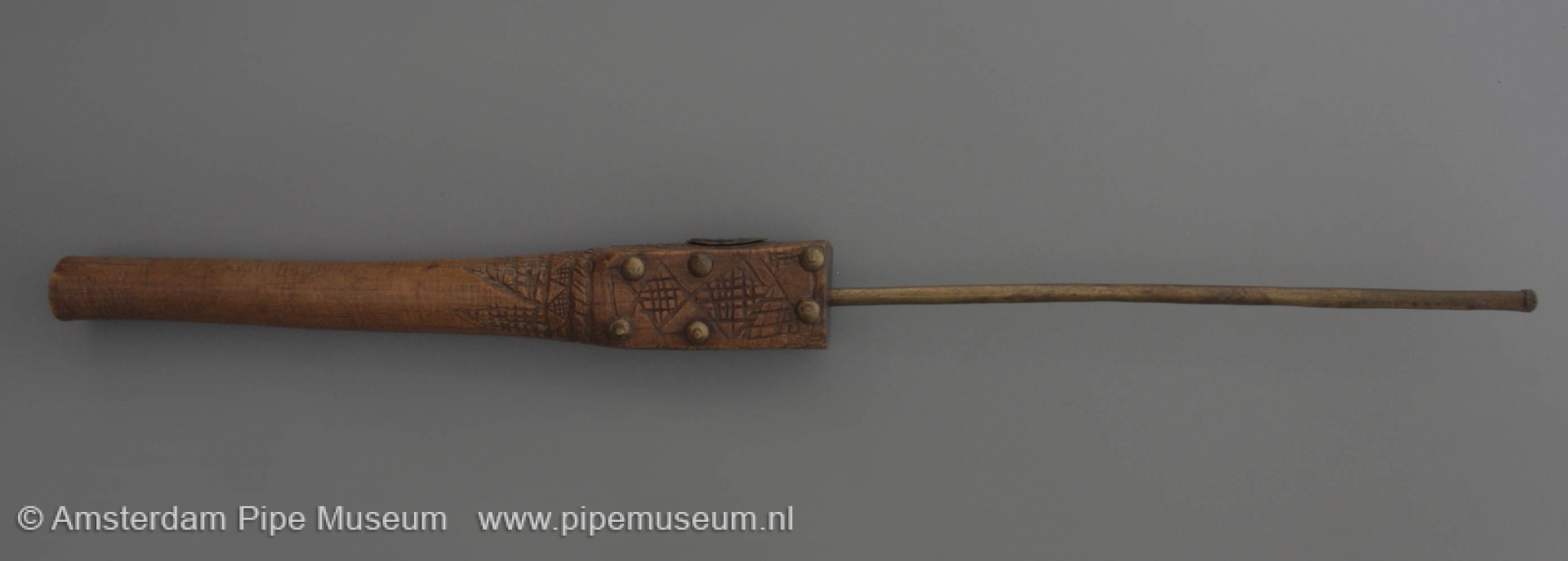
Characteristic is the metal lining of the bowl interior and the simple connection to the metal stem. The soft wood is far from fire-resisting, so the metal interior is a necessity. A piece of shield metal was cut into a shape to fit for the diameter of the bowl. The rim on the top has been hammered onto the pipe.
The four sided part, we might say the pipe bowl, is decorated with simple carving in a vague pattern including several brass nails. The use of these nails doesn’t give a clue in attributing the pipe to a region of origin. The nails were applied in Congo, the stem looks more like work from Cameroon, while the techniques of the finishing indicates Angola. In short, the pipe is an interesting item with a mix of techniques and difficult to attribute to a specific tribe. The combination of techniques however, indicates that this pipe should origin from the south-west of Africa, but not likely from countries as Cameroon or Congo where the smoking culture was too developed for such an unusual pipe. I should therefore suggest an origin from the west coast of Africa, like Angola.

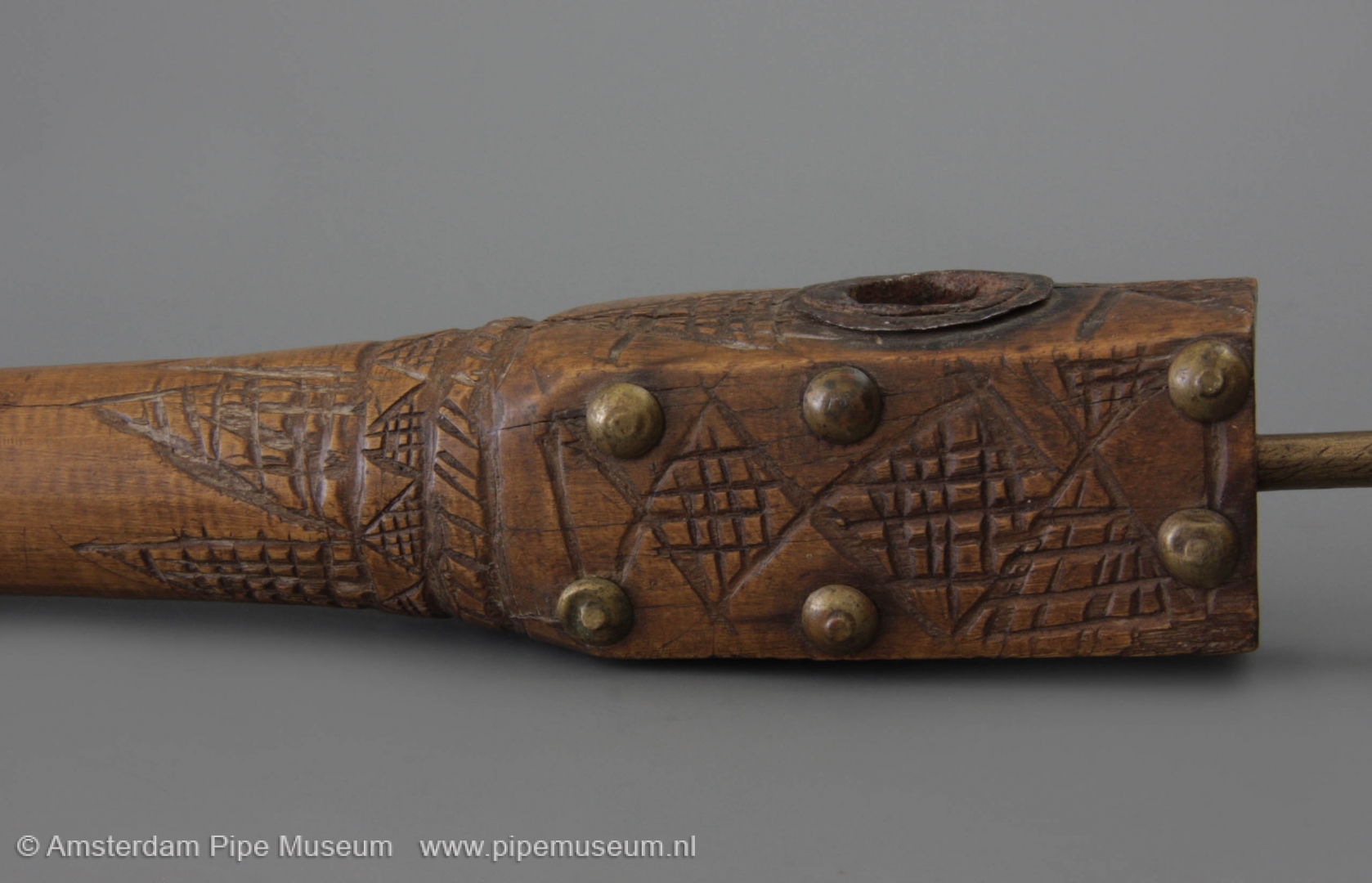
It is not very understandable how this pipe has been smoked. A comfortable balance is not achieved, not even when the pipe is held by the round end-part on the bowl. Because of the thin stem the mouthpiece turns between the lips and sooner or later the tobacco falls out. A negative fact is therefore the lack of a place for easy holding situated somewhere between the bowl and the mouthpiece.
Amsterdam, Pijpenkabinet collections Pk 19.145
A characteristic Ovimbundu pipe
Traditional and characteristic is this tobacco pipe showing a standing man in the stem, originating from the Ovimbundu tribe. Every detail on this pipe refers to this Angolese tribe from central Angola. The funnel shaped pipe bowl with its wide top and smaller flat base, is typical for all pipes of this tribe. The stem, straight from the bowl, holds a carved decoration on the top, in this case in a rather coarse design. The end of the pipe shows an extremely conical shape, where the iron stem is inserted. The whole construction measures 61 cm in length.
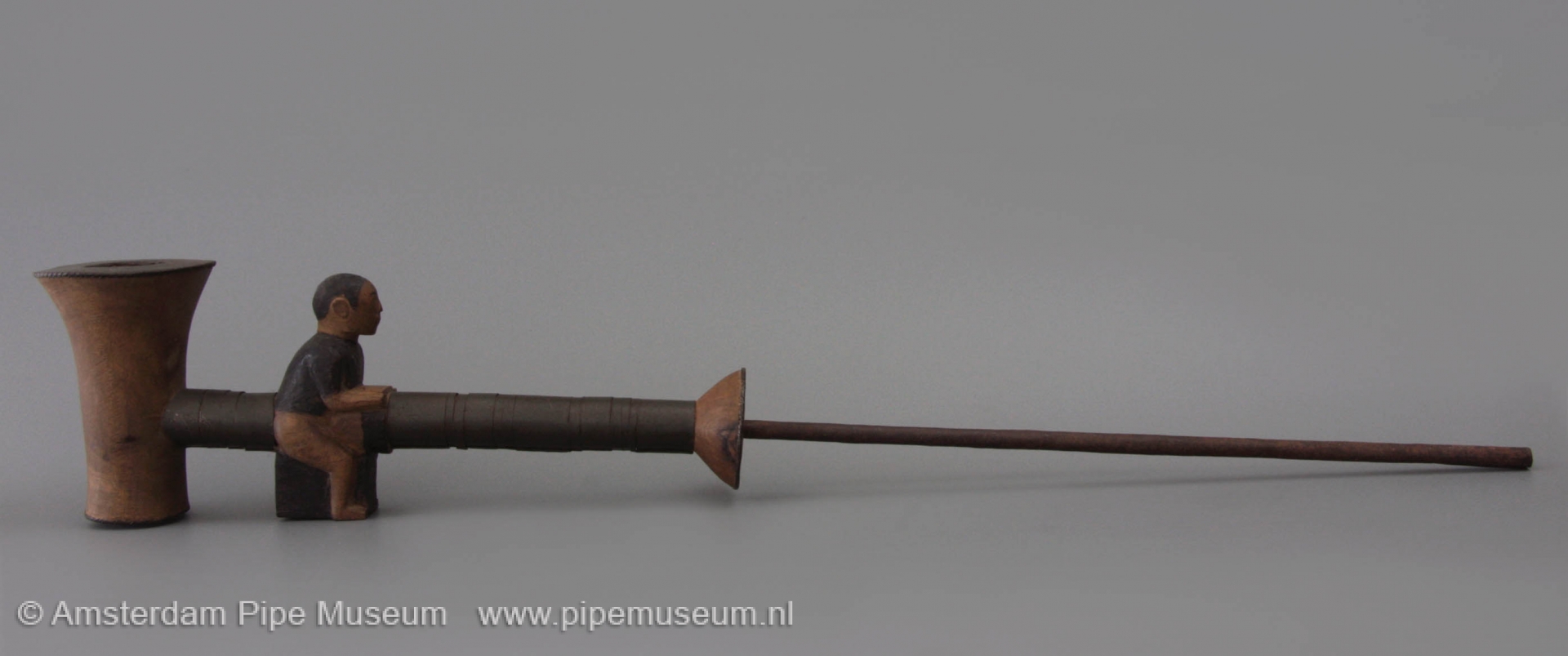
Normally the decoration of an Ovimbundu pipe sits on the middle part of the stem. An interesting variation of persons is known, sitting or laying, sometimes even several persons. The same subjects occurs on other crafts of this tribe, such as stools and chairs. This tobacco pipe shows only one standing person, dressed in narrow trousers and short jacket, his hair in shortcut. The carving is a bit clumsy, but still very attractive.
Another characteristic of the Ovimbundu pipes is the use of sheet metal, that is also shown on this pipe, both practical and decorative. The bowl is covered with metal on the top, inside and at the bottom, that holds – as an extra – some stones in a hollow space that give a noise by moving the pipe. Further on, several metal bands are added on the stem, closed at the lower end in a specific way of folding the metal. Originally the metal will have been bright and shining, now it has acquired a dark gray patina.
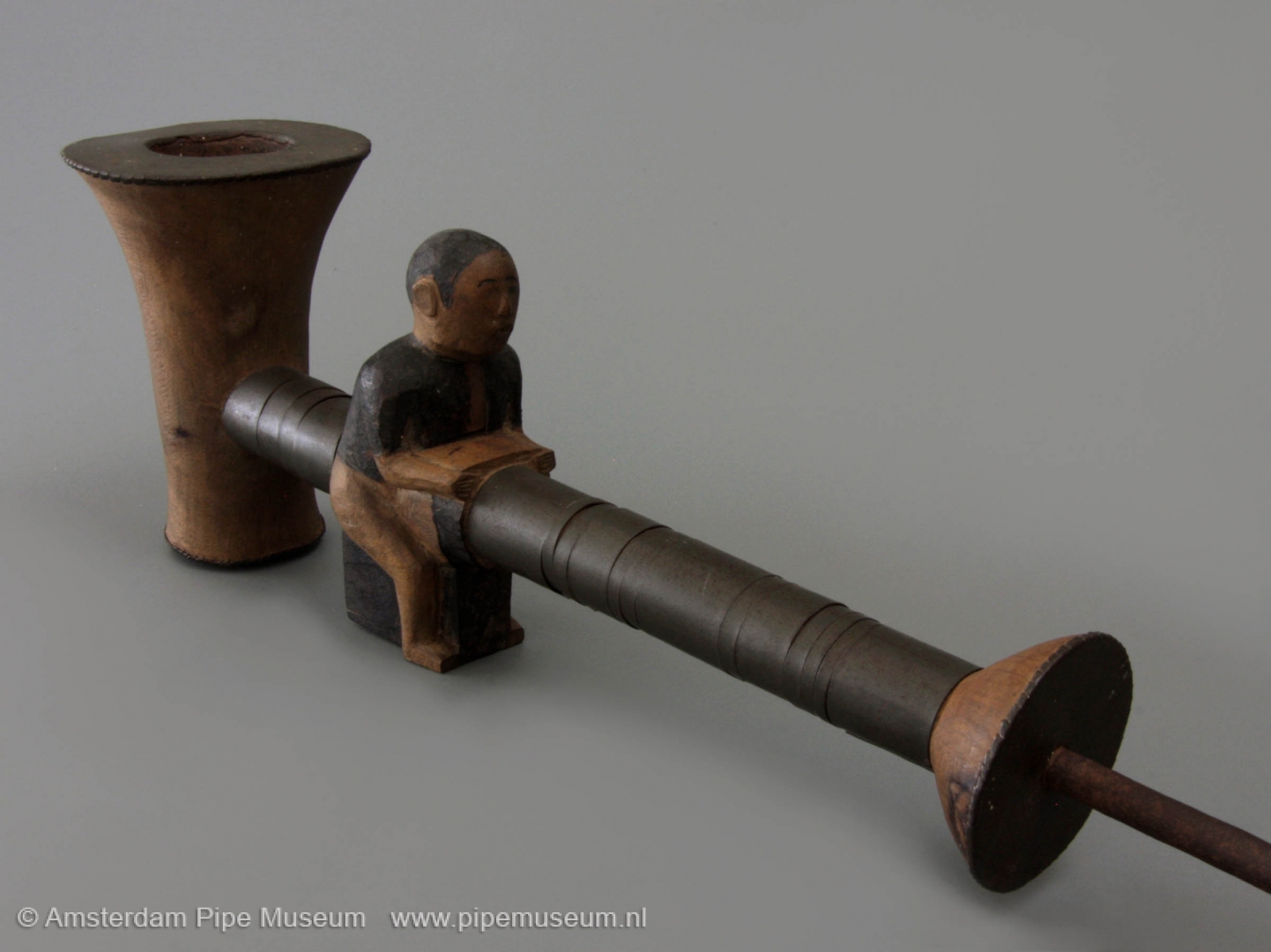
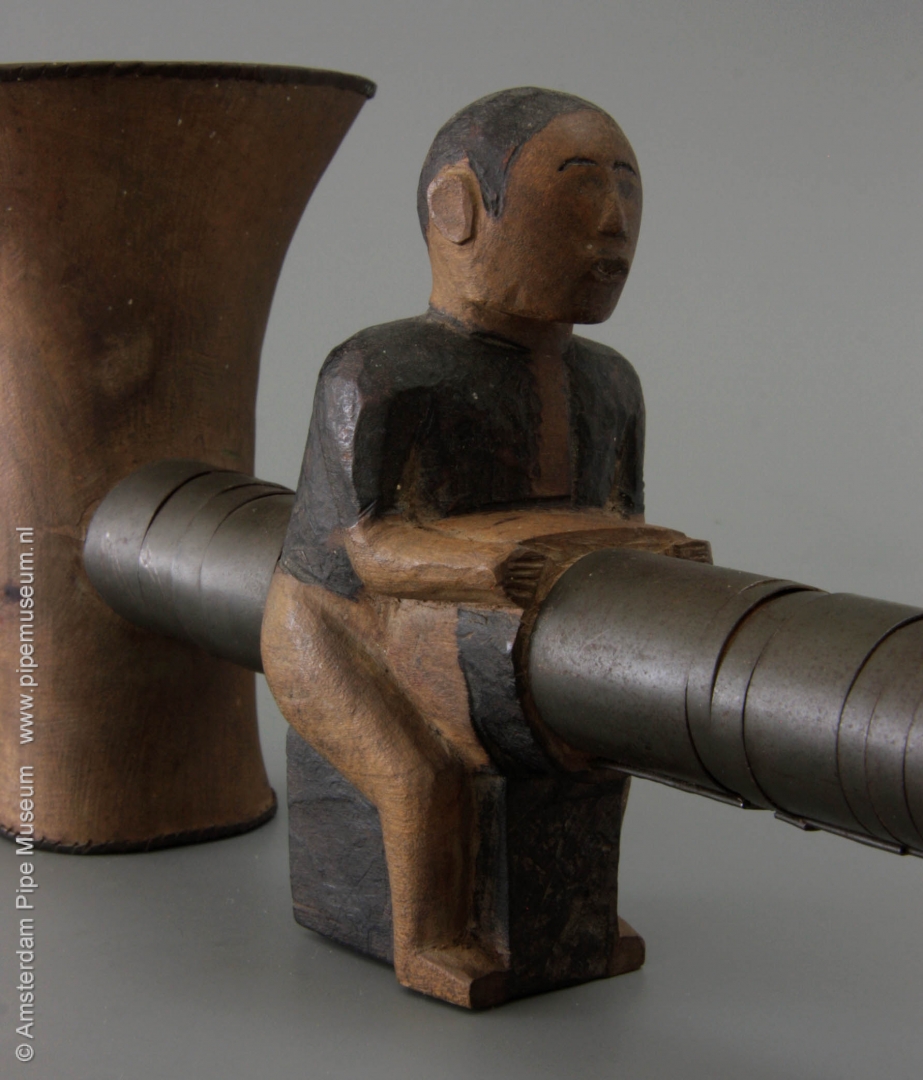
In this pipe the tribal characteristics are obvious, although the dating is far more recent than you would expect for such a traditional object. I guess the pipe dates from the 1950’s, perhaps some earlier. This attractive tribal pipe has been preserved and traded in the ex-colonizer Portugal, through which it reached the Pijpenkabinet collection.
Amsterdam, Pijpenkabinet collections Pk 19.146
© Don Duco, Pijpenkabinet Foundation, Amsterdam – the Netherlands, 2007